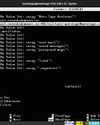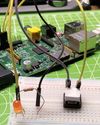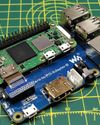Virtualisation
Linux Format
|December 2018
Jonni Bidwell learns to master containers and VirtualBox, enabling him to run Linux any time, any place and anywhere…

Virtualisation has been around since the mainframes of the 60s, where the activities of one program were separated from another. Later, IBM’s CP-40 introduced the notion of a hypervisor and the ability to run multiple OSes concurrently.
Virtualisation proper took off in earnest in the mid-2000s, when 64-bit processors appeared with explicit features for running guest OSes more efficiently. Being able to virtualise machines (in theory) made sysadmins’ lives much easier. Whole systems could be snapshotted, backed up and restored as easily as files. Critical updates could be tested in a virtual sandbox, which vastly reduced the possibility of things catching fire when they were rolled out to physical systems. Multiple VMs could exist on the same system, yet for all intents and purposes be isolated from one another, improving security and efficiency. Home users as well could enjoy the benefits of trying out this “Lye-nux” thing without risking ruination of their incumbent OS.
The hardware has evolved even more since, and you can now pass whole devices to virtual machines (VMs). This makes possible, among other things, running a Windows VM with its own fully accelerated, dedicated graphics card.
After VMs came containers, which rather than implementing a whole OS re-use the host’s kernel and contain just the bits needed to run a particular service or set of services. This enables them to ship with the libraries they require, obviating the problem of conflicting versions when software is installed on a different machine. This makes them more portable than VMs, and to some extent offers a similar level of isolation.
このストーリーは、Linux Format の December 2018 版からのものです。
Magzter GOLD を購読すると、厳選された何千ものプレミアム記事や、10,000 以上の雑誌や新聞にアクセスできます。
すでに購読者ですか? サインイン
Linux Format からのその他のストーリー

Linux Format
Create your first WebSocket service
Mihalis Tsoukalos explains how to use the Go programming language to work with the WebSocket protocol.
9 mins
April 2023

Linux Format
Fantastic Mr Firefox
Nick Peers takes a trip down memory lane to reveal the story behind the rise - and slight fall - of Mozilla's popular web browser.
9 mins
April 2023

Linux Format
Set up your terminal and email like it's 1983
Jump in the hot terminal time machine with Mats Tage Axelsson who emails from the command line using the latest technology.
8 mins
April 2023

Linux Format
Universal layer text effects with GIMP
Posters use them, films and presentations are hard to imagine without them: text effects. Attract attention with Karsten Günther and GIMP.
8 mins
April 2023

Linux Format
Jump to a federated social network
Nick Peers reveals how you can get up and running with this free, decentralised and non-profit alternative to Twitter.
9 mins
April 2023

Linux Format
Free our SOFTWARE!
Taking anything for granted is dangerous, so Jonni Bidwell and Mike Saunders revisit how the free software movement got started to help free us from proprietary tyranny!
4 mins
April 2023

Linux Format
Master RPI.GPIO
Les Pounder goes back to the early days of the Raspberry Pi - and his career with this classic library! -
5 mins
April 2023

Linux Format
Waveshare Zero to Pi3
Transform your Pi Zero into a Pi 3, they promised Les Pounder, but it's more like adding on go-faster stripes.
2 mins
April 2023

Linux Format
The Best OPEN SOURCE Software Ever!
In an attempt to trigger controversy, Michael Reed and Neil Mohr unequivocally state these are the greatest free software apps ever. Probably. We’re just trying to be helpful.
19 mins
April 2023

Linux Format
Linux-Mandrake 7
Simplicity and a wide range of applications make this a great distribution for all Linux users.
2 mins
April 2023
Translate
Change font size

